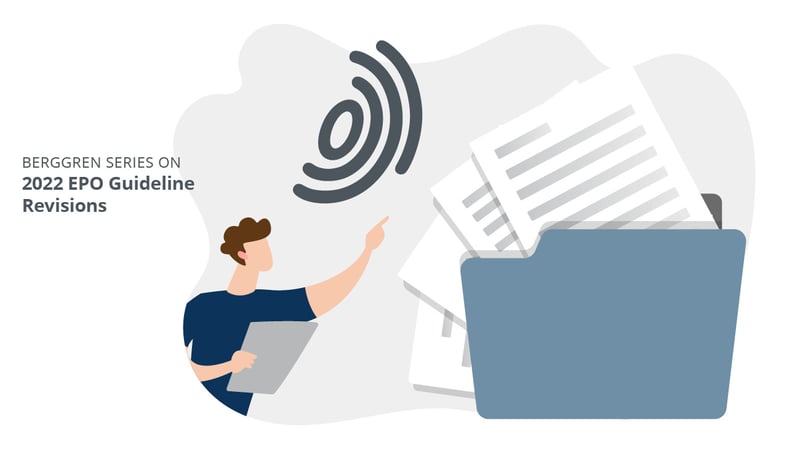In this first article in our 2022 series covering updates to the European Patent Office’s Guidelines for Examination, we look at changes made to sections of the Guidelines concerning adaption of the description. For the next several weeks, we will address specific revisions to the 2022 Guidelines in the European patent section of Lexology’s Monday newsfeed and our blog on Thursday.
Historical Background
The European Patent Office has, over the years, developed a practice of requesting that the description of a patent application be amended to remove any inconsistencies between the claims and description before a patent is granted. Sometimes inconsistencies arise as a result of narrowing amendments made during prosecution. At other times, they come up because a single patent application covers many different embodiments or even different inventions.
For a long time, this was a fairly weak request that could either be ignored or resolved by making minor changes to the description, such as changing the word “embodiment” to “example”. Recently, however, the EPO has been cracking down and requiring more significant amendments to the description.
This was codified in the 2021 update to the Guidelines, which included expansive comments regarding the need to remove any inconsistencies between the description and the claims. Just one year later, these comments have been almost entirely rewritten in section F, IV, 4.3 of the 2022 version of the Guidelines.
2022 Guideline Revisions
According to the new 2022 version of the EPO’s Guidelines for Examination, “Any inconsistency between the description and the claims must be avoided if it could throw doubt on the subject-matter for which protection is sought”. This includes parts of the description that on the surface appear to describe ways to carry out the invention but are not actually encompassed by the claims.
In general, features mentioned in the description that are broader, or more general, than those defined in the claims would be considered inconsistent. Features that are narrower are not inconsistent provided they fall within the scope of the claims.
The previously common practice of changing “embodiment” to “example” is specifically highlighted as an unacceptable practice, and the Guidelines state that unambiguous expressions must be used to highlight inconsistent embodiment or features, for example by adding "outside the subject-matter of the claims”.
One small boon for applicants is that the Guidelines now state that the examiner will provide examples of embodiments in the description that are deemed to be inconsistent with the claims. Previously, the burden fell entirely on the applicant.
Where We Go From Here
According to the updated text of the Guidelines,
“According to Art. 84, second sentence, the claims must be supported by the description. This means that there must not be inconsistency between the claims and the description”.
This is a bold claim that many would disagree with. Indeed, a recent decision from the EPO Boards of Appeal (which has caused at least a modicum of excitement among European Patent Attorneys) stated that there is, in fact, no basis in the EPC for refusing a patent application for the sole reason that the embodiments provided in the description are more general than the embodiments defined in the allowable claims.
It remains to be seen whether this decision has any impact on the EPO’s overall approach to description amendments. For the time being, it almost certainly will not, because EPO examiners generally follow the Guidelines for Examination, not the case law of the Boards of Appeal. However, given the attention that the case has received since publication, it seems likely that it will be taken into account in a future revision of the Guidelines.
While description amendments may not seem to be a particularly exciting topic, amendments made to the description can have a significant impact on the scope of a granted patent, for example, in jurisdictions such as Germany and the United Kingdom that employ doctrine of equivalents in an infringement analysis. The doctrine of equivalents allows for infringement of a claim even if every feature of the claim is not literally or precisely infringed. Depending on the specific criteria used in national courts, infringement under the doctrine of equivalents may be found when, for example, the different features perform the same function or have the same effect as those in the claim.
According to the EPO’s practice, such features should be removed from the description because they do not fall explicitly within the scope of the claims. However, if such features are explicitly disclaimed as “outside the subject-matter of the claims”, it would be difficult for the patentee to argue in court that such features should be covered by the claims. Deleting the “inconsistent” features may therefore be a better option where amendments are absolutely insisted upon by the EPO.
Despite the ostensibly mundane nature of the topic, these changes have significant implications on practice before the EPO and in actions before national courts. We can expect to see more development on this topic in the coming years.
Please follow Berggren’s weekly updates on the 2022 EPO Guidelines which we will publish each Monday in the Lexology newsfeed over the next several weeks. For any questions about the updated EPO Guidelines please contact us at internationaldesk@berggren.fi.





